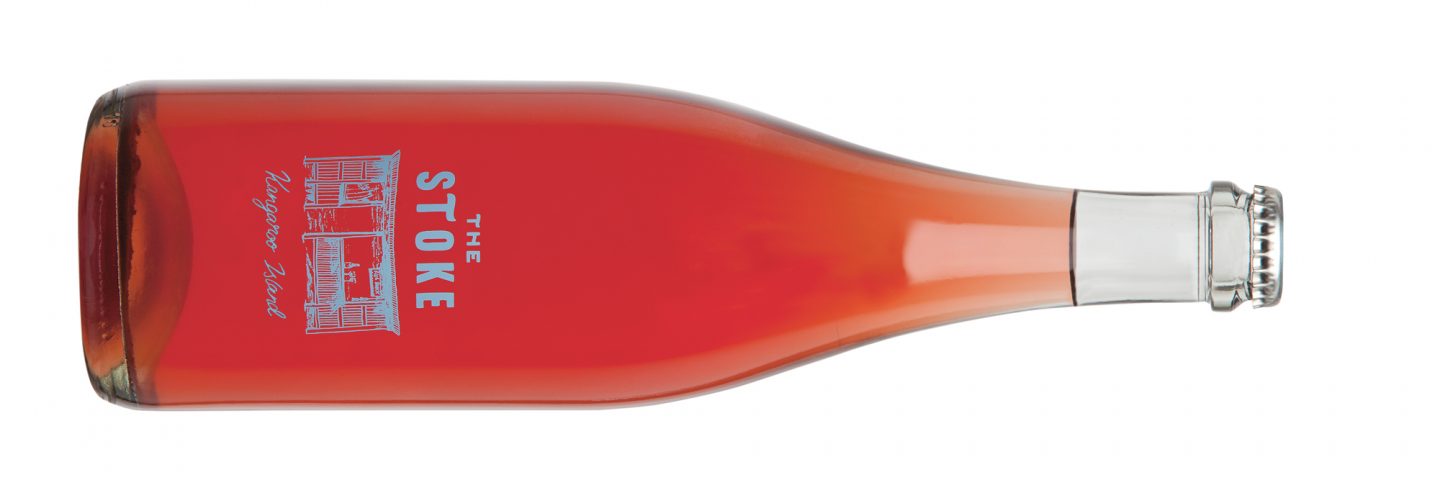Hot 100 Wines:
Stoked with the fun of fizz

With their 2019 Pétillant Naturel, The Stoke winemakers Nick and Rebecca Dugmore have blended a love of fizz with a passion for Kangaroo Island growers, that more than won over our 2019/20 Hot 100 Wines judges.
Fizzing is an intrinsic side-effect of fermentation. So, if you put a still fermenting wine in a sealed bottle, it develops bubbles of CO2. And providing the bottle doesn’t blow up, you end up with sparkling wine.
The ancient method that harnesses this process predates Champagne-making and sports its own solemn French designation, méthode ancestrale. It is, however, much better known as pétillant naturel, inevitably truncated by irreverent Anglos to “pet nat”. It was traditionally harnessed for cider-making, but in the last decade or so has become very popular as a low-tech method of making sparkling wine. Given its simplicity and arcane origins, it’s a gimme for the “natural” winemaking fraternity. And while its adoption has been driven chiefly by its hipster exponents, it is starting to turn up all over the winemaking landscape. Cullen’s, one of Western Australia’s most eminent wineries, makes two pet nats, and it will set you back $50 to sample one.
Most pet nats are more down to earth, sometimes a little too literally. If the wine effervesces too boisterously, much of it will exit the bottle in a plume when the cap comes off. Finishing fermentation in the bottle can also create idiosyncratic flavours, and pet nat wines frequently enjoy – or endure – a reputation for funky characters.
Winemaking couple Nick and Rebecca Dugmore have a strong affection for the style, and have teamed it with their love of Kangaroo Island fruit to produce the 2019 The Stoke Petillant Naturel, a handsomely watermelon-coloured sparkling wine that charmed its way into the top 10 of the Hot 100 SA Wines.
The pair, whom the vagaries of international winemaking brought together in New Zealand (Bec is Scottish), now base themselves at a small shared winery, Southern Artisans, near Mount Jagged in the Fleurieu Peninsula. The locale allows them access to vineyards in both the Adelaide Hills and Kangaroo Island, and also lets Nick go surfing.
The Stoke kicked off as a part-time venture five years ago with two tonnes of grapes. Nick, who up until the advent of COVID-19 was making wine for bigger companies, has just gone full-time on his own brand. And where the couple previously relied on KI growers for their grapes, the recent purchase of 12 hectares of vineyard on the island will make them self-sufficient from 2021.
COVID-19 gave them a bit of a push in the back, Nick says. “It seemed like a really good time to do it, because rather than purchasing the fruit, we can pay me to look after our own vineyard and start to develop a bit of consistency with our wines, and with our brand and our story.”
At The Stoke, the pet nat method has been finessed and brought to heel by fermenting the wine to dryness and then adding a shot of grape juice to the wine to bring on the bubbles in the bottle. It also makes the level of fizz more predictable. “My wife’s a sparkling winemaker, so she did a lot of the calculations to figure out how much CO2 you’d end up with, and she pretty much nailed it with this one,” Nick says.
“It’s an exciting wine to make, probably because of the risk factor. It’s quite technical to make, but also a lot of fun to make and a lot of fun to drink. It really suits Kangaroo Island – it’s quite summery and beachy and fresh.”
The wine is an unusual combination of varieties, pairing tempranillo with riesling. Originally destined to make separate wines, the riesling was lacking aromatics and looking too acid and linear, Nick says, while the tempranillo was too dark to be suitable for its original destination as a rosé.
“But blended together they looked really nice, and they were in such tiny quantities it made good sense,” Nick says. The previous year’s pet nat, the first ever made with KI fruit, teamed shiraz and sauvignon blanc. It also had serendipitous origins, after currawongs made off with the riper, low-hanging shiraz from under the protective netting.
The style has, however, now won its spurs, and while there is no 2020 version because of a lack of suitable fruit, Nick says it will definitely reappear in The Stoke repertoire.
All you’ll need is a bottle opener to deal with the crown seal. Mine’s ready.
